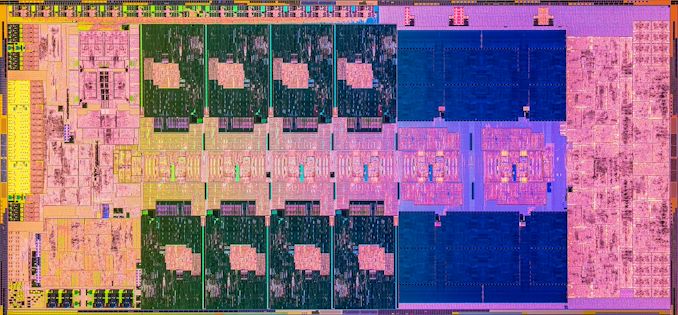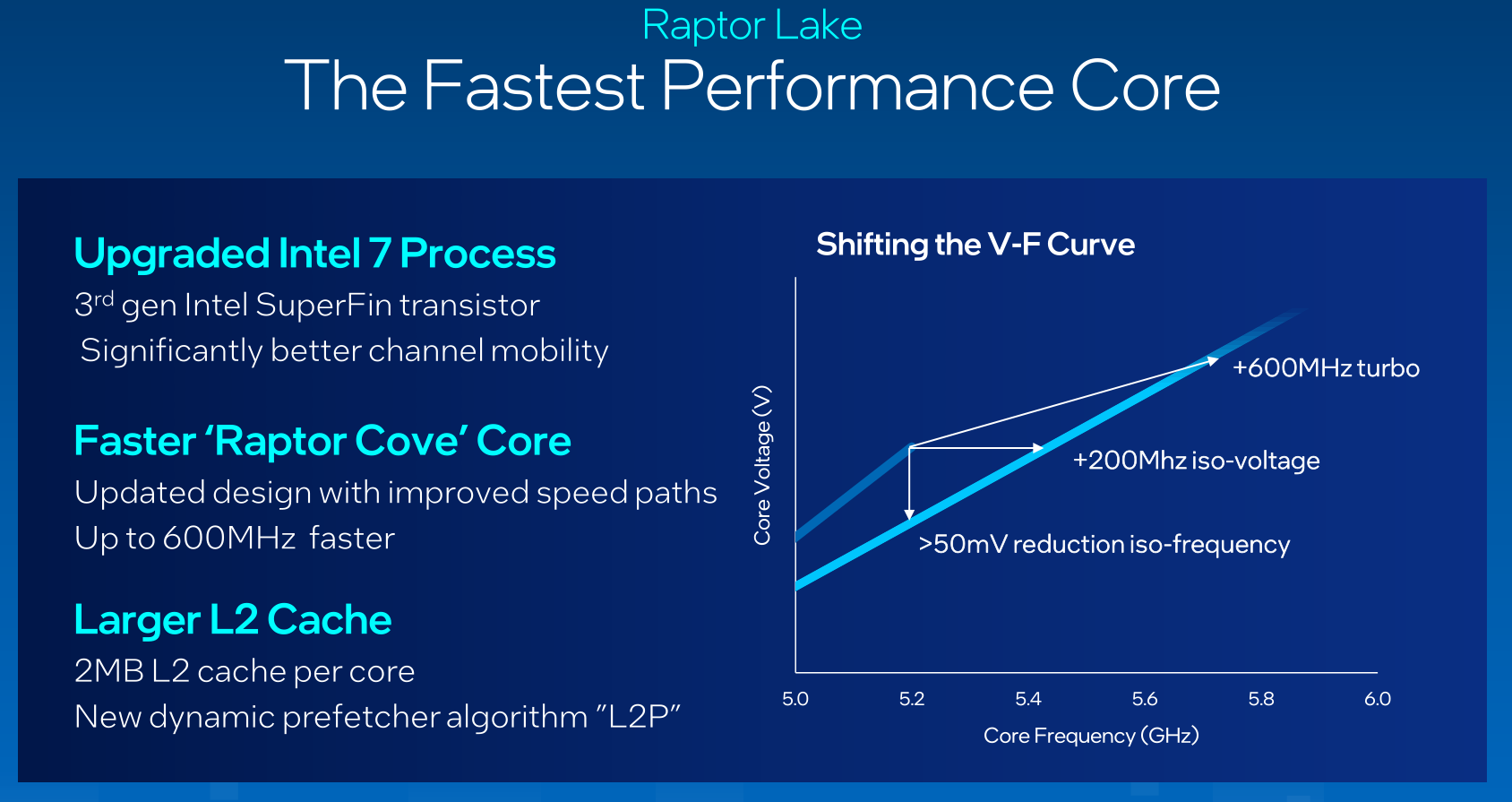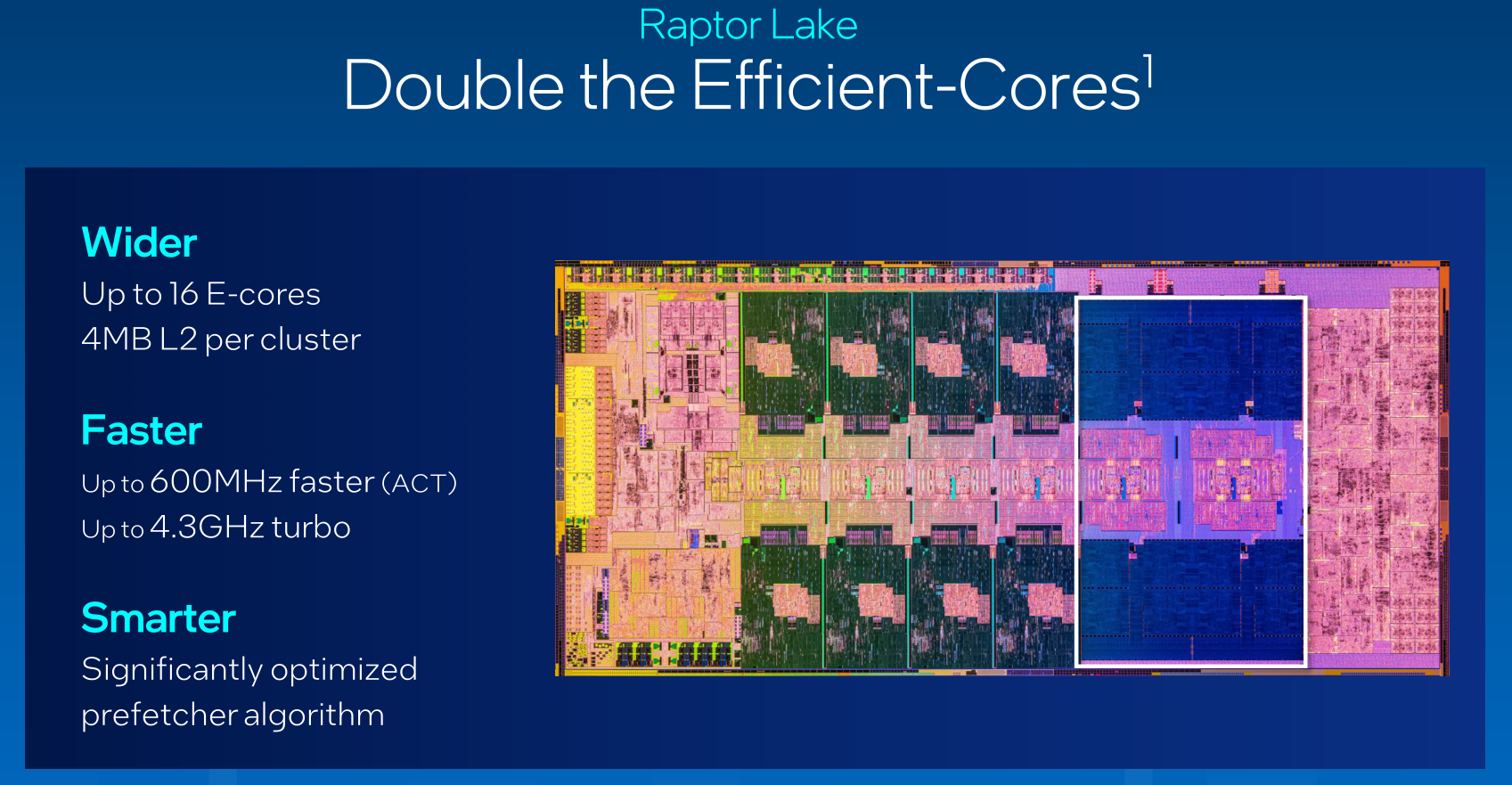Intel Core i9-13900K and i5-13600K Review: Raptor Lake Brings More Bite
by Gavin Bonshor on October 20, 2022 9:00 AM ESTRaptor Lake In Detail: Raptor Cove P-Cores, More Efficiency Cores
When it comes to architecturally dissecting the differences between Intel’s Alder Lake and Raptor Lake processors, both are based on a similar process. Intel’s 12th Gen Core (Alder Lake) series and the latest 13th Gen Core (Raptor Lake) are based on its Intel 7 manufacturing processor, although this isn’t to be confused with 7 nm, as Intel 7 is a 10 nm process node. This means that Raptor Lake isn't a new core so to speak, especially not a redesign of its existing 10ESF core, but more augmentation. Intel has opted for improvements to its underlying memory and cache structures.

Intel Raptor Lake Core die image (Core i9-13900K)
The new Raptor Cove performance (P) cores replace the previous Golden Cove variants, with Intel specifying that Raptor Cove is based on an ‘enhanced’ version of its Intel 7 process using its 3rd generation of SuperFin transistor. With this newly optimized process combined with a better overall VF curve over the last age, Intel hopes to leverage the benefit from a higher frequency without increasing power levels too much.
Focusing on changes to the cache, the 13th Gen Core series has more L2 cache. For the new Raptor Cove core, Intel has added more L2 cache when compared to Alder Lake, with 1.6x more with 2 Mb per P-core. The levels of L2 cache assigned to each array of E-cores now equates to 4 Mb; up from 2 Mb. This means Intel has improved the L2 cache on both core types. For the L3 cache, Intel hasn't made any strides and has left things unchanged.
Adjusting to the Voltage Frequency (VF) cure has allowed Intel to squeeze out even more gains about frequency versus voltage. In the case of Raptor Lake, Intel has managed to increase the peak P-Core frequency by a significant amount, up to 1 GHz in some cases. An example is the Core i9-13900K which has a maximum turbo frequency of up to 5.8 GHz; this equates to just over 11.5% over the Core i9-12900K. As per the released V/F curve optimizations, Intel has managed to eke out 200 MHz at ISO-Voltage, with a reduction of 50 mV at ISO frequency.
One thing to highlight about Intel’s 13th Gen Core series processors is the discrepancy between the base TDP, which for its entire launched stack (as of 10/20) is 125 W. The turbo or PL2 values are the same for the Core i9 and Core i7 models which are set at 253 W. This is an increase of 12 W from the corresponding 12th Gen Core i9 chips (241 W), and up by 63 W on the Core i5 series like for like. With the element of adding double the amount of E-cores, even with a more efficient V/F curve, there had to be tradeoffs when it came to power.
Raptor Lake and E-Cores: Same Gracemont Cores, Just More of Them
As we reviewed the previous generations of Intel Core i9-12900K processors, Intel has kept the same Gracemont-based Efficiency (E) core for Raptor Lake. The key difference when comparing the flagships of both generations, the Core i9-13900K has double the amount of E-cores compared to the previous generation. The doubling of E-cores in combination with the refined Raptor Cove core design for the P-cores means that the Core i9-13900K now has a total of 24-cores, with other SKUs benefitting from an increase in E-cores too.
Still, even with double the E-cores, the power penalty for doing this shouldn’t be an issue, at least not from a cooling perspective. As is with a high-performance processor and the high PL1/PL2 power it needs to stretch its legs, premium cooling would never go a miss. Intel isn’t officially recommending a minimum limit to cooling, but a low-performance cooler will almost guarantee thermal throttling as the Thermal Velocity Boost (TVB) for 13th Gen is set to 70°C.
In addition to the changes above, Intel’s 13th Gen Core series (unlike AMD’s Zen 4) offers support for both DDR5 and DDR4 memory. Further to the previous 12th Gen, the 13th Gen now supports faster DDR5 memory (DDR5-5600 versus DDR5-4800), an increase of 16.6%. Bandwidth and speeds for DDR4 memory remain at 3200 MT/s. Still, it allows users to match a lower-value processor without paying over the odds for DDR5 memory, which should decrease in price over time (hopefully).
Intel Thread Director: Windows 11 22H2 (or Newer) is Recommended
Since Intel’s 12th Gen Core series launch late last year, there was much furor around task scheduling in combination with Intel’s (new at the time) Thread Director built into the cores. While there were clear issues with Thread Director in combination with Windows 10, the Windows 11 operating system alleviated the issue of parking high single-threaded workloads on cores that otherwise wouldn’t be the best option (E-Cores). Although Windows 10 did in essence work with Intel Thread Director, it wasn’t really good at highlighting efficiency, and this is where Windows 11 came into play for optimal performance with Alder Lake.
Fast forward to now, and with all the additional E-cores in play with Raptor Lake, the latest update at the time of writing, Windows 11 22H2, offers the latest enhancements in the partnership between Intel, Microsoft, and the inner workings of Intel’s Thread Director. With a hybrid architecture and non-optimized software, it makes things a bit of a mess, but as per Intel’s guidance, they do recommend users use Windows 11 with 22H2 (or newer) for optimum performance when using 13th Gen Core series processors.
Over the next page is more information about the latest Z790 chipset which accompanies the Raptor Lake processors with this launch. From then on in, we'll detail our new CPU suite for 2023 and beyond, as well as see if Intel's 13th Gen Core Raptor Lake series can take a bite out of the competition. The associated pages and their contents are highlighted below:












169 Comments
View All Comments
nandnandnand - Monday, October 24, 2022 - link
I can see a couple of things that make sense:1. Buy onto the platform early, upgrade very late. Like 1700X to 5800X3D. Except that didn't work for every motherboard on AM4.
2. Buy a budget chip, upgrade to an expensive chip 1+ gen later. The Ryzen 5 7600X is currently the cheapest but at $300 it doesn't really qualify.
Nobody should buy AM5 or Raptor Lake (new system) right now. Wait for 7800X3D/Zen5 and Meteor Lake. Reply
Kangal - Monday, October 24, 2022 - link
This.Initially the r7-1700 and x370 offered mixed value, and the upgrade path looked great. But AMD wasn't able to properly fulfil their AM4 promise.
So perhaps AMD realised their issues, and fixed things for AM5. So perhaps but the most expensive motherboard and the best value cpu to upgrade the cpu later. Or maybe nothing has changed, since AMD is so far ahead of Intel when it comes to motherboard relevancy.
So for new system builders, you can blow the budget and go all-in on a new Intel + Nvidia tower. For the best value builders, customising an older AMD (5800x3D) and RDNA is the way to go. For the risk takers, you can overpay for things that are going to last, and cut-back on things you know yobare going to upgrade (gpu, cpu, more storage).
Reply
GeoffreyA - Tuesday, October 25, 2022 - link
The promise of upgrading is great, but sometimes doesn't work out as planned. I built a 2200G + B450 Tomahawk in 2019, with the hope to upgrade to a 6-core APU later on. Now, the 5600G is the one to go for, but has considerable issues when joined with the Tomahawk. So, I tend to think I'll just wait for a whole new system, AM6 perhaps, who knows? Replytvdang7 - Sunday, October 23, 2022 - link
Is it to much for the reviewer to add the 7900x and 7700x into the graphs just so we know what we are dealing with ? ReplyRyan Smith - Monday, October 24, 2022 - link
We do not currently have those chips. AMD has only sampled the top and bottom SKUs.We'll get them eventually through other means. We just don't have them right now. Reply
o01326 - Sunday, October 23, 2022 - link
Just signed up to comment this: why are you benchmarking Civ IV by FPS? ReplyTheinsanegamerN - Monday, October 24, 2022 - link
The same reason they were, up until this review, still using a 2080ti for their CPU gaming benchmarks. Replycoolkwc - Monday, October 24, 2022 - link
this review is failed, don't even post what's the core temperature under stress? So difficult to get that reading huh? ReplyAnnnonymmous - Monday, October 24, 2022 - link
Transient power spikes with an RTX 4090 and 13900K mean you will need at LEAST a 1500w power supply to prevent random computer shutdowns. That's crazy! Of course, this will only happen when you are running a game 4K, Max Settings, with Ray Tracing enabled. Still, getting 1,000-1,200w spikes is crazy! Replytrueonefix - Monday, October 24, 2022 - link
Awesome Reply